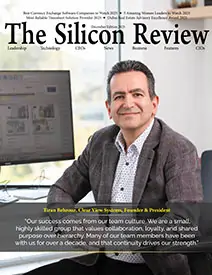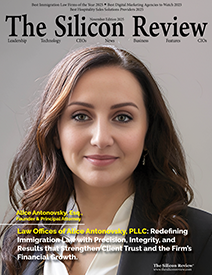HMS Software’s TimeControl, a top-rated multi-purpose timesheet system, is designed to meet extensive project management needs
The Silicon Review
![]()
“TimeControl is simple at the front end but highly robust behind the scenes.”
HMS Software was founded in 1984 as a consulting firm specializing in deploying project management software to medium- and large-sized organizations. Over the next decade, it achieved notable success, serving a diverse client base that included companies such as Bombardier, Philips, Ontario Hydro, Hydro Quebec, Oerlikon, and General Motors. However, in 1994, HMS Software underwent a transformation, shifting its focus from a project management distribution and consulting firm to a software publisher. Recognizing a demand for a versatile timesheet system that could facilitate project management as well as other corporate processes such as payroll, human resources, and billing, TimeControl was released in 1994 as a response to this demand.
HMS Software has implemented its enterprise timesheet and project management software, TimeControl globally, serving a multitude of renowned organizations worldwide, including AMD, Andritz, CANAM, EXFO, Interpol, Kelly Services, Volvo Novabus, the Quebec Government, and Zoetis.
HMS Software is headquartered in Montreal, Canada.
The Silicon Review reached out to Chris Vandersluis, President, Chairman, and CEO of HMS Software, and here’s his response.
Interview Highlights
Q. As a leading multi-purpose timesheet system, what are TimeControl’s key focus areas?
TimeControl must be many things for many different parts of the organization simultaneously. TimeControl data is often used simultaneously in multiple company processes like payroll, HR, project management, and billing. That makes flexibility a key component of TimeControl’s architecture. Clients have enormous flexibility in how to define the system data, how to condition data for every table, how to manage approvals, and how to display it. A second critical element of TimeControl’s focus is auditability. For a timesheet system that might be used for payroll, billing, job costing, or government compliance reports, the ability to audit any result in the system is essential. TimeControl complies with the requirements of the US Defense Contract Audit Agency (DCAA) and numerous other government compliance requirements, such as the US IRS Research Credits reporting requirements and the Canadian requirements to submit SRED Research and Development tax claims. This extends TimeControl’s control mechanisms in every direction within the system. Finally, all that functionality has to be consumable, and since its first release in 1994, TimeControl has included the ability to keep most of its functionality in the background. For end users who will use the product for a few short minutes a week, TimeControl is the ultimate in simplicity. Where data can be prompted for users, it is. Where data can be filtered down to show only what the user needs, it is; even the menu options are different for users. Yet, for administrators who must use TimeControl data to enable all those background processes, a robust set of functions is key. TimeControl is simple at the front end but highly robust behind the scenes.
Setbacks are a part of every growing business. Tell us about a few roadblocks and learning lessons that helped TimeControl grow through the years.
Every software publisher has challenges, and HMS is no exception. One of the most challenging aspects of our business is that we are dependent on numerous layers of technology, and every one of those layers is being enhanced and changed on a constant basis. It’s not enough for us to work with one browser, one database, or one operating system. All of those layers change. We have learned that budgeting a portion of our technical resources to layer management and maintenance has to be a constant. So, every version of TimeControl includes an internal inquiry into what has changed, what versions of each layer we can still support, and what new versions of each layer need attention. In some cases, that brings new functionality, as it did with our most recent TimeControl Mobile release, which supported dark mode. In other cases, there is better performance available, but in all cases, it’s work that we just have to do, even if it’s not directly tied to new features of our system.
Q. What strategies do you have in place to encourage innovation in your company?
TimeControl innovation comes from numerous sources. First, we canvass our clients and prospective clients to see if they experience any gaps in TimeControl’s functionality. Much of our future enhancements in TimeControl come from client interactions. Where a client explains a desired feature or change, we record that and identify any other clients who have asked for the same or similar changes. Our technical staff are regularly rotated from development to technical support to deployment roles, so everyone in the technical group gets opportunities to interact directly with clients. Next, we encourage our internal staff to promote enhancements to the product based on their own experience. We have regular innovative meetings where we gather ideas from the staff and review ideas from other sources to see what we should be focusing on and investing in. This would include ensuring we are keeping up with advances in security protocols. Third, we follow trends in our industry and in technology to make sure that we are keeping up with changes in user experience, productivity, integrations with other systems, and changes in supporting technology like browsers, servers, and more.
Q. Can you provide us with one or two success stories, detailing specific client challenges and how TimeControl’s solutions contributed to their success?
There are many, but let me just focus on a couple. The first, and one of our larger clients, is global computing leader Advanced Micro Devices (AMD). When we met them, AMD was using an internally written timekeeping system that had reached its end of life, and with AMD now being a global company, they were looking for a timesheet service that would be served from the cloud and have tremendous flexibility. TimeControl fit the bill. In use by almost 20,000 users, TimeControl was able to prove that it could scale to meet AMD’s needs, and the TimeControl API (Application Programming Interface) allowed AMD to tie TimeControl to numerous internal processes and systems.
“Our project progress data is never stale,” said AMD Program Manager Dardig. “With our old system, we could only access weekly or monthly reports. The new dashboards have energized management interest in reporting.”
The second client to talk about is one of our oldest clients, EXFO. EXFO is a publicly traded world leader in test and service assurance solutions for network providers in the telecommunications industry. It began its journey with TimeControl over 25 years ago. As a Canadian company, EXFO needed to track time and money spent on R&D for tax purposes and was able to use TimeControl to provide down-to-the-penny auditable time tracking to meet the Finance department’s needs. At EXFO, over 1,000 users enter their timesheet data into TimeControl every day, and the resulting reports are used by project management to advance the progress of tasks. We are delighted to have had EXFO use TimeControl so successfully for over a quarter century.
We have been privileged to tell both of these stories in case studies on our website.
Tell us what’s next for TimeControl.
There is a never-ending list of new features and plans for TimeControl. We have been focusing this year on the deployment of a premium edition of TimeControl Online called TimeControl Project. We have so much depth in the entry, analysis, and tracking of project actuals, we felt it would make sense to dedicate some effort to project planning. TimeControl Project is a unique take on the project management software industry. Rather than trying to push all corporate users into one frame of thinking, in TimeControl Project, we have employed the same kind of flexibility to look at project management from multiple perspectives at once. Executives will look at project management from a strategic perspective. Project and resource managers will look at project management from an operational perspective, and front-end users will look at project management from a day-to-day tactical perspective. TimeControl Project brings a toolbox to display, analyze, and report on project data from those different points of view. Our next version of TimeControl will include even more functionality within TimeControl Project.
On the TimeControl and TimeControl Industrial fronts, we are launching a brand new module called TimeControl BI to bring business intelligence analysis into TimeControl. Now managers can create long-term data mining directly inside the product to look at trends and data associations within the vast amount of TimeControl data each client amasses.
There’s a lot more, of course. We are continuing to invest in our free TimeControl mobile app, extending TimeControl’s reachability.
Chris Vandersluis | President, Chairman & CEO
Chris Vandersluis is a prolific spokesperson on enterprise project management software and systems, as well as enterprise timesheet systems. Chris is an economist who graduated from Montreal, Canada’s McGill University.
He spent five years working with Microsoft on their Enterprise Project Management Partner Advisory Council in the early 2000s. Chris’s writing has appeared in a number of publications, including Fortune Magazine, the American Management Association’s Handbook on Project Management, the Ivey Business Journal, the Project Management Institute’s PMNetwork magazine, Project Times and Microsoft’s TechNet. He maintains his writing on the popular blog, http://www.epmguidance.com.
Chris has taught advanced project management at McGill University and often speaks at project management association functions across North America and around the world.
He has been a member of the Project Management Institute since 1986.
_2025-12-15_12-44-58.webp)


_2025-11-17_06-38-14.webp)

 (1)_2025-10-21_13-35-14.webp)
